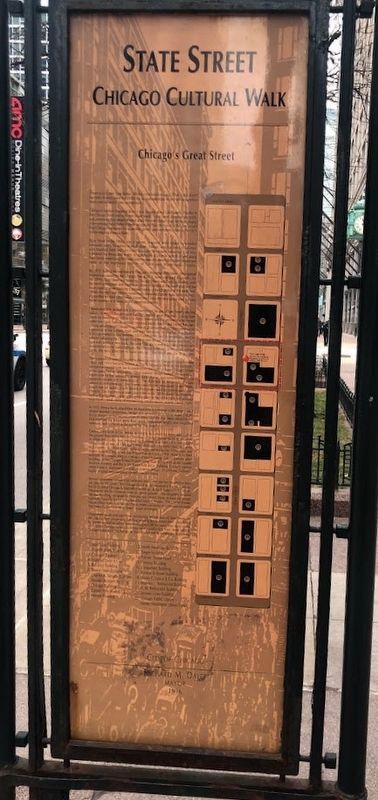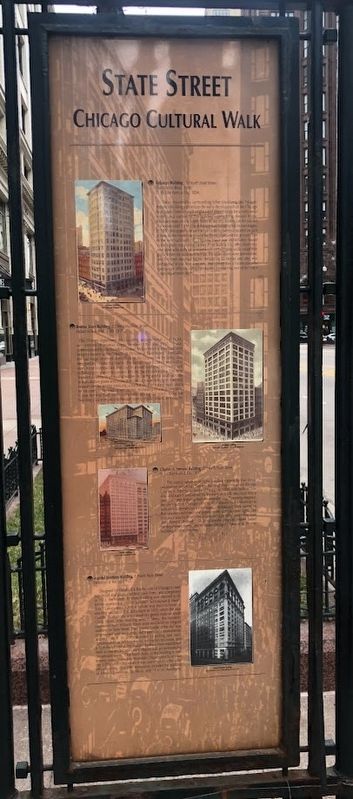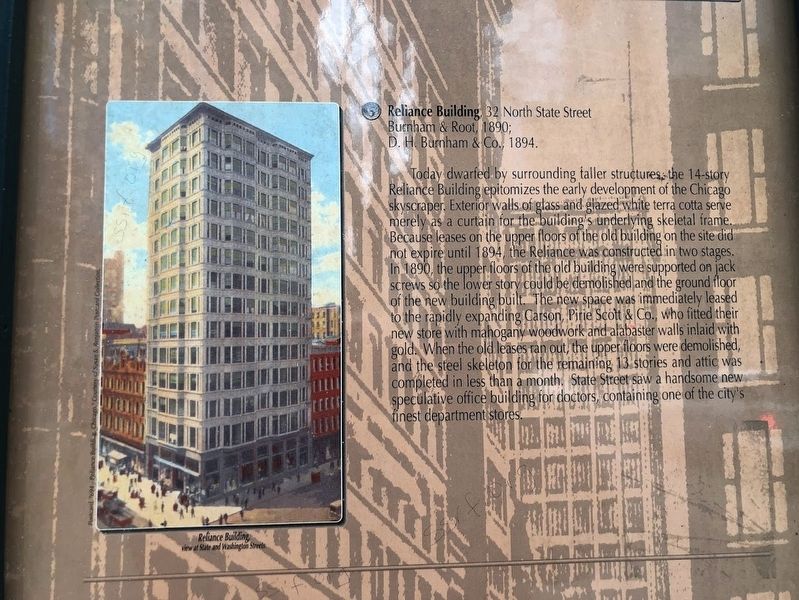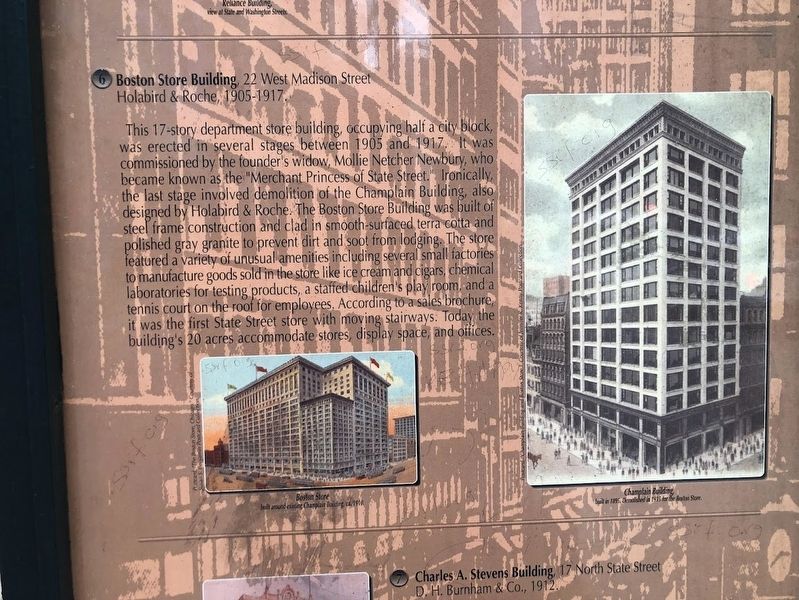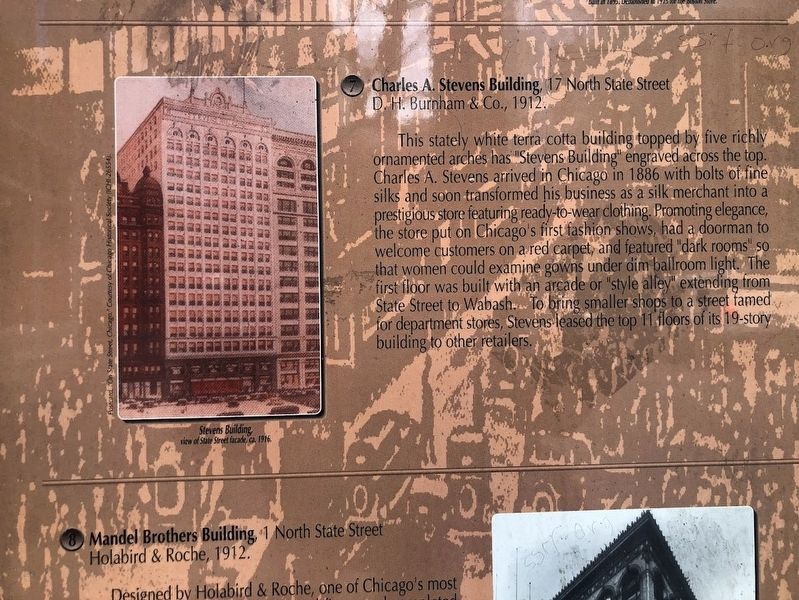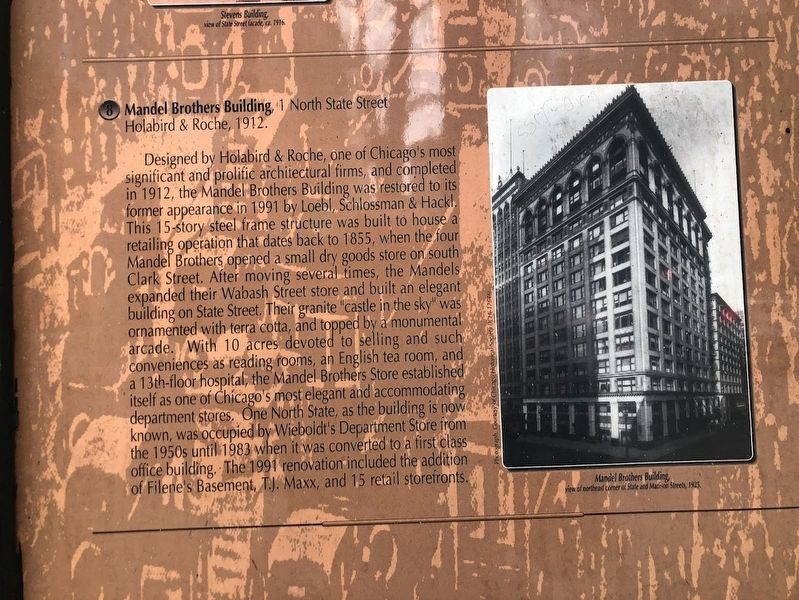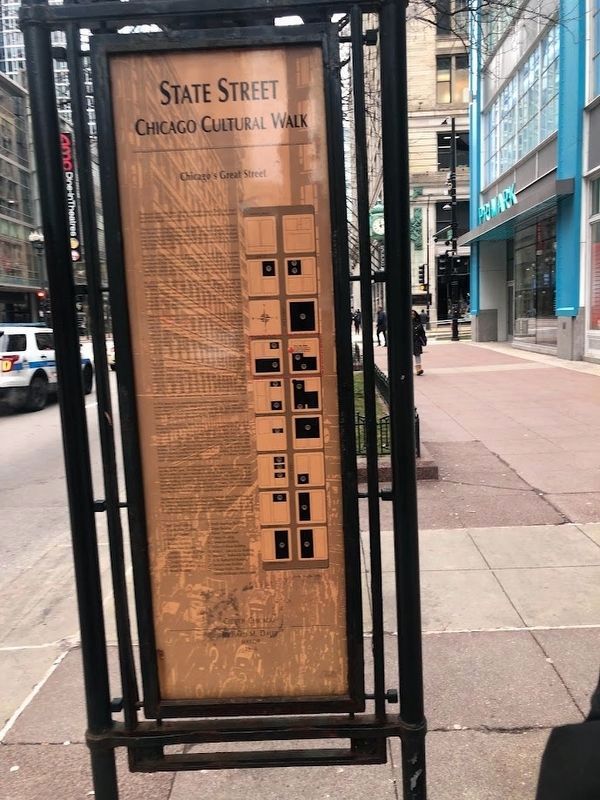Loop District in Chicago in Cook County, Illinois — The American Midwest (Great Lakes)
State Street
Chicago Cultural Walk
There is only one State Street. Widely celebrated in song, “That Great Street” has been known since the 1870s for its concentration of premier department stores and world-class architecture.
Chicago's earliest shopping district was located along Lake Street. Parallel to the Chicago River and only one block south, Lake Street absorbed the traffic in commerce that already existed along the river’s edge. State Street developed when entrepreneur Potter Palmer recognized that the curve of the river would limit Chicago's potential economic growth and envisioned State is the city’s major retailing thoroughfare.
State Street in the 1860s was a narrow, unpaved street edged by wooden sidewalks and a confusion of small shops. Palmer, who had been in business with Marshall Field and Levi Leiter in a Lake Street store before the Civil War, translated his dream into reality by purchasing a ¾ mile stretch of land along State Street, convincing Field and Leiter to open the street’s first major department store at the northeast corner of State and Washington Streets.
By 1870, State Street had become Chicago’s shopping destination. Widespread destruction caused by the Chicago Fire of 1871 merely delayed its growth. Find the 1890s, State Street was home to Chicago's finest retail establishments, with the more prestigious and expensive stores clustered at the north end and the more popular stores carrying a greater variety of merchandise at the south end. When the city's first subway system was completed under State Street in 1943, it provided for direct pedestrian connections from the mezzanine level stations to the basements of many of the department stores.
Department store architecture is as important to Chicago as State Street’s retailing history. It reflects the genius of the city's earliest great designers. Lining State Street are buildings by William Le Baron Jenney and the architects who trained under him: Louis Sullivan, William Holabird, Martin Roche, and Daniel Burnham. Taking advantage of Chicago's location as a railroad hub, its rapid commercial expansion in the lumber, coal, and steel industries, its population explosion (Chicago tripled in size between 1870 in 1890), and its immediate need to rebuild following the Chicago Fire, these men set out to create a new building type with a whole new look. Because Chicago’s central business district was restricted in size by Lake Michigan, the Chicago River and, to the south, railroad yards, the only direction to build was up. The result was the skyscraper.
The commercial style developed by these pioneers in Chicago's Loop between 1880 and 1910 became known as the “Chicago School of Architecture.” Recognized world-wide for its modernism, the style of these Chicago School skyscrapers had no precedent. Their exterior design looks like a grid, an expression of the building’s interior metal frame, and ornamentation was generally simple and nonhistorical. The style is an outgrowth of major advances in technology. Steel frame construction, developed in the 1880s, meant that tall buildings with flexible floor plans could be erected quickly and cheaply. The first sheets of plate glass rolled in the 1880s allowed for maximum light and ventilation. Faster and safer elevators in the 1870s made tall buildings practical, and new fireproofing techniques made them safe.
In 1893, Jenney firmly established his reputation as a pioneer in the development of steel skeleton construction, designing huge buildings to house Siegel, Cooper & Co. (known as the Second Leiter Building) and the Fair Store (demolished). Distinguished by broad open floor space, impressive height, and simplified exteriors, both ushered in the era of the “Big Store.”
Carson, Pirie Scott & Co., before moving to its current location, operated on the ground floor of the Reliance Building. This tall narrow building sheathed in white terra cotta, was designed by Burnham and Root. It is universally recognized as one of Chicago’s most distinguished early steel and glass skyscrapers. In 1899, Louis Sullivan began designing the Schlesinger and Mayer Store building, which has housed Carson’s since 1904. There is no finer example of a simple, elegant Chicago School building. Like numerous other buildings of the Chicago School located along State Street, such as the Mandel Brothers Building and the A.M. Rothschild & Co. Building, Carson's interior metal frame is expressed in a gridlike exterior design. In addition, Sullivan’s highly original ornamentation embellishes the frame.
Several handsome commercial buildings never intended for department store use also dot the street. The Chicago Building, by Holabird & Roche, is among the city’s stellar Chicago School office buildings. Rapp & Rapp’s 1921 Chicago Theatre recalls romantic time of movie palaces. The elegantly detailed Mentor Building, designed by Howard Van Doren Shaw, echoes the design ingenuity typically found in his beautiful country houses. The current Palmer House Hilton is the third Palmer House Hotel and serves as a constant reminder that Potter Palmer was State Street’s major developer.
Department stores and significant architecture tell the story of State Street. As the 20th century progressed, retailing became firmly established―anchored by numerous distinguished department stores. At the same time many of the city's finest Chicago School buildings were constructed. State Street reflects Chicago's mercantile beginnings: its history is rich and its architecture is splendid.
[Side 2:]
5. Reliance Building, 32 North State Street
Burnham & Root, 1890;
D. H. Burnham & Co., 1894.
Today dwarfed by surrounding taller structures, the 14-story Reliance Building epitomizes the early development of the Chicago skyscraper. Exterior walls of glass and glazed white terra cotta serve merely as a curtain for the building's underlying skeletal frame. Because leases on the upper floors of the old building on the site did not expire until 1894, the Reliance was constructed in two stages. In 1890, the upper floors of the old building were supported on jack screws so the lower story could be demolished and the ground floor of the new building built. The new space was immediately leased to the rapidly expanding Carson, Pirie Scott & Co., who fitted their new store with mahogany woodwork and alabaster walls inlaid with gold. When the old leases ran out, the upper floors were demolished, and the steel skeleton for the remaining 13 stories and attic was completed in less than a month. State Street saw a handsome new speculative office building for doctors, containing one of the city's finest department stores.
6. Boston Store Building, 22 West Madison Street
Holabird & Roche, 1905-1917.
This 17-story department store building, occupying half a city block, was erected in several stages between 1905 and 1917. It was commissioned by the founder's widow, Mollie Netcher Newbury, who became known as the "Merchant Princess of State Street." Ironically, the last stage involved demolition of the Champlain Building, also designed by Holabird & Roche. The Boston Store Building was built of steel frame construction and clad in smooth-surfaced terra cotta and polished gray granite to prevent dirt and soot from lodging. The store featured a variety of unusual amenities including several small factories to manufacture goods sold in the store like ice cream and cigars, chemical laboratories for testing products, a staffed children's play room, and a tennis court on the roof for employees. According to a sales brochure, it was the first State Street store with moving stairways. Today the building's 20 acres accommodate stores, display space, and offices.
Charles A. Stevens Building, 17 North State Street
D. H. Burnham & Co., 1912.
This stately white terra cotta building topped by five richly ornamented arches has "Stevens Building" engraved across the top. Charles A. Stevens arrived in Chicago in 1886 with bolts of fine silks and soon transformed his business as a silk merchant into a prestigious store featuring ready-to-wear clothing. Promoting elegance, the store put on Chicago's first fashion shows, had a doorman to welcome customers on a red carpet, and featured "dark rooms" so that women could examine gowns under dim ballroom light. The first floor was built with an arcade or "style alley" extending from State Street to Wabash. To bring smaller shops to a street famed for department stores, Stevens leased the top 11 floors of its 19-story building to other retailers.
Mandel Brothers Building, 1 North State Street
Holabird & Roche, 1912.
Designed by Holabird & Roche, one of Chicago's most significant and prolific architectural firms, and completed in 1912, the Mandel Brothers Building was restored to its former appearance in 1991 by Loebl, Schlossman & Hackl. This 15-story steel frame structure was built to house a retailing operation that dates back to 1855, when the four Mandel Brothers opened a small dry goods store on south Clark Street. After moving several times, the Mandels expanded their Wabash Street store and built an elegant building on State Street. Their granite "castle in the sky" was ornamented with terra cotta, and topped by a monumental arcade. With 10 acres devoted to selling and such conveniences as reading rooms, an English tea room, and a 13th-floor hospital, the Mandel Brothers Store established itself as one of Chicago's most elegant and accommodating
department stores. One North State, as the building is now known, was occupied by Wieboidt's Department Store from the 1950s until 1983 when it was converted to a first class office building. The 1991 renovation included the addition of Filene's Basement, T.J. Maxx, and 15 retail storefronts.
Topics. This historical marker is listed in these topic lists: Architecture • Industry & Commerce • Roads & Vehicles. A significant historical year for this entry is 1870.
Location. 41° 52.971′ N, 87° 37.663′ W. Marker is in Chicago, Illinois, in Cook County. It is in the Loop District. Marker is on State Street south of Washington Street, on the right when traveling north. Touch for map. Marker is at or near this postal address: 27 North State Street, Chicago IL 60602, United States of America. Touch for directions.
Other nearby markers. At least 8 other markers are within walking distance of this marker. Reliance Building (within shouting distance of this marker); Chicago Building (about 400 feet away, measured in a direct line); Marshall Field and Company Building (about 400 feet away); The Heyworth Building (about 400 feet away); Old Saint Mary's Cathedral (about 500 feet away); Jewelers Row (about 500 feet away); The Rotary Club of Chicago (about 500 feet away); a different marker also named Jewelers Row (about 500 feet away). Touch for a list and map of all markers in Chicago.
More about this marker. The marker is one of several erected (likely in the late 1990s) about the history of Chicago's State Street. The front side of the marker is identical on all of the signs, while the back side is unique to its location, highlighting buildings in the immediate vicinity.
Credits. This page was last revised on February 22, 2024. It was originally submitted on February 1, 2024, by Sean Flynn of Oak Park, Illinois. This page has been viewed 52 times since then. Photos: 1, 2, 3, 4, 5, 6, 7. submitted on February 1, 2024, by Sean Flynn of Oak Park, Illinois.
